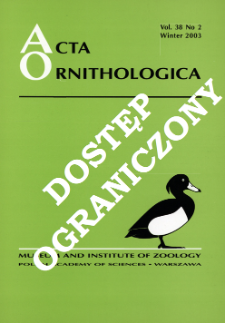
Obiekt
Tytuł: Spatial distribution of nesting and foraging sites of two Acrocephalus warblers in a Mediterranean reedbed
Twórca:
Poulin, Brigitte (1962– ) ; Lefebvre, Gaëtan (1962– ) ; Metref, Slimane
Data wydania/powstania:
Typ zasobu:
Inny tytuł:
Acta Ornithologica, vol. 35, no. 1 ; Rozmieszczenie przestrzenne miejsc gniazdowych i żerowisk dwóch gatunków z rodzaju Acrocephalus w trzcinowiskach śródziemnomorskich ; Nesting and foraging sites of two Acrocephalus species
Współtwórca:
Polska Akademia Nauk. Muzeum i Instytut Zoologii ; Meeting of the European Ornithologists' Union (2 ; 1999 ; Gdańsk)
Wydawca:
Muzeum i Instytut Zoologii PAN
Miejsce wydania:
Opis:
Referat wygłoszony na Second Meeting of the European Ornithologists' Union ; Bibliogr. s. 120-121 ; S. [117]-121 : il. ; 27 cm ; Streszcz. pol. Nazwy taksonów także w jęz. łac.
Typ obiektu:
Abstrakt:
Many reedbed passerines forage outside their nesting territory. This peculiar behaviour could allow reproductive individuals to feed in areas where resources are plentiful and/or to nest in areas where predation risks are low. These hypotheses were investigated for the Moustached Warbler Acrocephalus melanopogon and the Reed Warbler A. scirpaceus in a 40-ha of reedbed in southern France. Vegetation structure, abundance of arthropod-prey, location of singing males, and bird local abundance were estimated along three transects 1-km long and 125-m distant parallel to the shore. Reed density increased from the lake inland, concurrently with a decrease in plant diversity. Food availability (sweep-netted arthropods weighted by their occurrence in species diet) varied positively with plant diversity and negatively with reed density. The dummy-nest experiment suggested a negative relationship between predation risks and reed density. While local abundance of each Acrocephalus species correlated spatially with food abundance, singing males were distributed evenly among the three transects. This suggests that predation risk associated with vegetation density has little influence on nest-site selection. The regular spacing of singing males further suggests that predation risk is primarily affected by nest density.
Czasopismo/Seria/cykl:
Tom:
Zeszyt:
Strona pocz.:
Strona końc.:
Szczegółowy typ zasobu:
Artykuł ; Materiały konferencyjne
Format:
Identyfikator zasobu:
Źródło:
MiIZ PAN, patrz sygn. czas. P.257, Vol. 35, No 1 ; MiIZ PAN, patrz sygn. czas. P.4568, Vol. 35, No 1 ; kliknij tutaj, żeby przejść
Język:
Prawa:
Prawa zastrzeżone - dostęp ograniczony
Zasady wykorzystania:
Digitalizacja:
Muzeum i Instytut Zoologii Polskiej Akademii Nauk
Lokalizacja oryginału:
Biblioteka Muzeum i Instytutu Zoologii PAN
Dofinansowane ze środków:
Program Operacyjny Innowacyjna Gospodarka, lata 2010-2014, Priorytet 2. Infrastruktura strefy B + R ; Unia Europejska. Europejski Fundusz Rozwoju Regionalnego
Dostęp:
Kolekcje, do których przypisany jest obiekt:
- Muzeum i Instytut Zoologii PAN > Czasopisma
- Muzeum i Instytut Zoologii PAN > Wydawnictwa MiIZ PAN > Acta Ornithologica
Data ostatniej modyfikacji:
2 paź 2020
Data dodania obiektu:
22 maj 2014
Liczba pobrań / odtworzeń:
97
Wszystkie dostępne wersje tego obiektu:
https://rcin.org.pl/miiz/publication/61274
Wyświetl opis w formacie RDF:
Wyświetl opis w formacie RDFa:
Wyświetl opis w formacie OAI-PMH:
Obiekty Podobne
Procházka, Petr (1976– )
Nowakowski, Jacek J.
Dyrcz, Andrzej (1933– )
Kruszewicz, Andrzej (1959– ) Dyrcz, Andrzej (1933– )
Fertikova, Katherine
Kuźniak, Stanisław (1933– ) Bednorz, Jan ( –2013) Tryjanowski, Piotr
Dunajewski, Andrzej (1908–1944)
Schmidt, Veronika (1973– ) Schaefer, Heinrich Martin Leisler, Bernd

 INSTYTUT ARCHEOLOGII I ETNOLOGII POLSKIEJ AKADEMII NAUK
INSTYTUT ARCHEOLOGII I ETNOLOGII POLSKIEJ AKADEMII NAUK
 INSTYTUT BADAŃ LITERACKICH POLSKIEJ AKADEMII NAUK
INSTYTUT BADAŃ LITERACKICH POLSKIEJ AKADEMII NAUK
 INSTYTUT BADAWCZY LEŚNICTWA
INSTYTUT BADAWCZY LEŚNICTWA
 INSTYTUT BIOLOGII DOŚWIADCZALNEJ IM. MARCELEGO NENCKIEGO POLSKIEJ AKADEMII NAUK
INSTYTUT BIOLOGII DOŚWIADCZALNEJ IM. MARCELEGO NENCKIEGO POLSKIEJ AKADEMII NAUK
 INSTYTUT BIOLOGII SSAKÓW POLSKIEJ AKADEMII NAUK
INSTYTUT BIOLOGII SSAKÓW POLSKIEJ AKADEMII NAUK
 INSTYTUT CHEMII FIZYCZNEJ PAN
INSTYTUT CHEMII FIZYCZNEJ PAN
 INSTYTUT CHEMII ORGANICZNEJ PAN
INSTYTUT CHEMII ORGANICZNEJ PAN
 INSTYTUT FILOZOFII I SOCJOLOGII PAN
INSTYTUT FILOZOFII I SOCJOLOGII PAN
 INSTYTUT GEOGRAFII I PRZESTRZENNEGO ZAGOSPODAROWANIA PAN
INSTYTUT GEOGRAFII I PRZESTRZENNEGO ZAGOSPODAROWANIA PAN
 INSTYTUT HISTORII im. TADEUSZA MANTEUFFLA POLSKIEJ AKADEMII NAUK
INSTYTUT HISTORII im. TADEUSZA MANTEUFFLA POLSKIEJ AKADEMII NAUK
 INSTYTUT JĘZYKA POLSKIEGO POLSKIEJ AKADEMII NAUK
INSTYTUT JĘZYKA POLSKIEGO POLSKIEJ AKADEMII NAUK
 INSTYTUT MATEMATYCZNY PAN
INSTYTUT MATEMATYCZNY PAN
 INSTYTUT MEDYCYNY DOŚWIADCZALNEJ I KLINICZNEJ IM.MIROSŁAWA MOSSAKOWSKIEGO POLSKIEJ AKADEMII NAUK
INSTYTUT MEDYCYNY DOŚWIADCZALNEJ I KLINICZNEJ IM.MIROSŁAWA MOSSAKOWSKIEGO POLSKIEJ AKADEMII NAUK
 INSTYTUT PODSTAWOWYCH PROBLEMÓW TECHNIKI PAN
INSTYTUT PODSTAWOWYCH PROBLEMÓW TECHNIKI PAN
 INSTYTUT SLAWISTYKI PAN
INSTYTUT SLAWISTYKI PAN
 SIEĆ BADAWCZA ŁUKASIEWICZ - INSTYTUT TECHNOLOGII MATERIAŁÓW ELEKTRONICZNYCH
SIEĆ BADAWCZA ŁUKASIEWICZ - INSTYTUT TECHNOLOGII MATERIAŁÓW ELEKTRONICZNYCH
 MUZEUM I INSTYTUT ZOOLOGII POLSKIEJ AKADEMII NAUK
MUZEUM I INSTYTUT ZOOLOGII POLSKIEJ AKADEMII NAUK
 INSTYTUT BADAŃ SYSTEMOWYCH PAN
INSTYTUT BADAŃ SYSTEMOWYCH PAN
 INSTYTUT BOTANIKI IM. WŁADYSŁAWA SZAFERA POLSKIEJ AKADEMII NAUK
INSTYTUT BOTANIKI IM. WŁADYSŁAWA SZAFERA POLSKIEJ AKADEMII NAUK
































